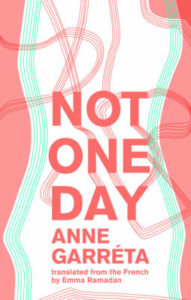Tr. by Emma Ramadan
How can a writer address desire, without giving in to the lazy cliches of the confessional — especially now, with the confessional at the center of contemporary literature? In the opening of Anne Garréta’s book Not One Day (Pas un Jour), published in 2001 but only now available in English, she reveals a deep discomfort with the growing fascination with self-narration. “All we seem to do nowadays,” she writes, “is tell and retell stories of our lives. For over a century, we’ve tried to grasp ourselves from the same angle, convinced that there’s only one key to unlock the secret of our subjectivity: desire.” But despite her reservations, Garréta finds herself drawn, perhaps perversely, to the confessional, to “play at a very old game that has become the hobbyhorse of a modernity balking at radical disenchantment: confession, or how to scrape the bottoms of mirrors.” Her own confessional, she decides, will be a playful one, in which the subject is never quite revealed, in which desire is never straightforwardly displayed.
Long associated with the Oulipo (she became a member in 2000), Garréta’s work contains strong formalist elements: foregrounded constraints and literary gamesmanship. Thus, she approaches the confession through a series of formal rules. Every day she will sit down at the computer and write for five hours, uninterrupted and unedited: “aiming to recount the memory . . . of one woman or another whom you have desired or who has desired you. That will be the narrative: the unwinding of memory in the strict framework of a given moment.” Then, when she is finished, she will arrange the women alphabetically, by initial. (The association with a bestiary, in all its cool zoology.)
There is nothing new about filtering the confessional subject through a formalist framework. The most famous Oulipan, Georges Perec, was well-known for placing his own autobiography as a child orphaned by the Holocaust into constrained projects like W, or a Memory of Childhood or Species of Spaces. But if Garréta is after something similar, there is deep ambivalence about the project. For Perec, the construction of an identity was a collection of fragments, a kind of resistance to obliteration — whereas, as Garréta sees it, our age is oversaturated with confession, and her participation is disenchanted, half-ironic. “Perhaps you will finally manage,” she writes, “in some feeble way, to emulate your peers, who recount their every experience, spewing out volumes of life matter — and buy into it.” The challenge she sets out for herself is to re-configure the confessional; to narrate the subject without quite believing in it: a challenge she links to the challenge of living and loving well — since, in Garréta’s mind, text and life are not fundamentally different. As she writes at the end of the opening, “. . . life is too short to resign ourselves to reading poorly written books and sleeping with women we don’t love.” If one must confess, they should do so intelligently. They must interrogate their own confession.
This conflict between confession and textual interrogation organizes the book, and provides its intellectual torque. Though Garréta presents her fragments as “the unwinding of memory,” they read more like discursive but nevertheless highly structured essays: meditations on particular kinds of desire, or philosophical investigations of how such desires might construct (or be constructed by) society. In the essay “B*,” she describes what attracts her to a particular woman as a “sensual proclivity for analysis,” a phrase which might define the book itself, though the exact arrangement of the words differs from fragment to fragment. In some, the reader is immersed in memory and sensual detail. In others, analysis predominates, both out of the necessity of complicating (and queering) what might otherwise be overdetermined narratives of subject and object, and also because Garréta has an innate tendency towards detachment. “You have a tendency to fade out of the world,” she writes, “the world in which we supposedly live.” The catalogue of desire is a way of re-establishing this connection, if only at a certain remove, in writing.
The analytic aspect of Garréta’s writing is apt and incisive. Her essayistic style is complex but lucid and, for the most part, direct. She is particularly sharp about the societal structure of desire, especially queer desire, as in this passage from “D*,” in which she and an ostensibly straight woman perform a secret seduction within a predominately hetero dinner party:
You both stand amidst a crowd and, from afar, through a phosphorescence of the gaze, of the body, receive the sign addressed to you and perceptible to you alone. You are thereby excepted from the general blindness. Exaltation of a lucidity that seems denied to mere mortals, to mere heterosexuals whose official relaxing of morals (which has not been accompanied by any dismantling of the old privileges and reflexes) has — to hear them complain, as their religion is somewhat comical, oscillating as it does between triumphant dogma and doleful creed — radically disenchanted desire. You are the only ones to see the desire that is not allowed, in what is not said aloud.
In this passage are echoes of the long and fertile French tradition of cultural criticism, with its emphasis on social structure and its languages of signs, as well as a particularly French irony towards the employment of these symbols. Garréta moves easily between cultural and personal registers; her entanglement with D* quickly becomes an opportunity to explore why she is excited by “the semiotics and hermeneutics, so singular, that stem from situations of secrecy that homosexuality may involve,” and why she so often seeks out ostensibly straight women, “who, for the most part, profess the dominant religion — probably, she suggests, because this secret communication is therefore stronger. In these essayistic sections, the objects of Garréta’s desire are often rendered primarily as opportunities to taxonomize different flavors of seduction and repulsion — what she refers to as her “Flaubertian tendency.”
The reference to Flaubert is not tangential. Although Garréta’s topics are contemporary, her references are often quite traditional, and her tone (and general attitude toward desire) has some surprising commonalities with 18th and 19th century French literary icons, all of them male. Not only does she render her project in reference to the preface to Rousseau’s Helene — “I have seen the mores of my times, and I have published these stories . . . would that I had lived in an age when I should have thrown them into the fire!” — and Stendhal’s own autobiography, which he wrote through the heteronym of Henri Brulard, but her lingering disgust towards the mechanisms of human connection reflects the curdled realism of Flaubert and the Goncourt Brothers. “Literature,” Garréta writes: “your last line of defense against the fierce disgust the human species tends to evoke in you.”
Sometimes, as in “D*,” this disgust has to do with the obligations of sex, its playacting, its enforced terms:
It was imperative, at risk of disappointing her, that you fuck her standing up in the hallway; in danger of endangering her pride, that you ravish her on the kitchen table; at risk of being accused of despising her, that you screw her thrown over the ottoman cushions in the parlor; for fear of making her no longer feel desirable, that you sodomize her in the bed of the guest room; to prove your passion, that you make her come on the four-poster bed; and to make sure that no piece of furniture had been neglected, that you finger her against the piano.
Unlike, say, the Goncourt Brothers (for whom sex carried the constant fear of venereal disease, and who once compared a prostitute to a pinned spider) Garréta is not disgusted by sex, per se. What she objects to is the way in which desire is forced into clichéd roles: the way that D*, in demanding Garréta degrade her, replicates the boring forms of a typical heterosexual relationship — and how, in relating it, Garréta is forced to render it as a grotesque parody of desire. “Just as narrative fiction is formally indistinguishable from referential narrative,” she writes, “(for they mimic each other to such a point that in these twin mirrors only mirages can be glimpsed), the description of pornographic, solipsistic alienation is indistinguishable from that of the perfect shared erotic passion.” No wonder Garréta is so deeply concerned with the aesthetics of narrative. If we do not pay scrupulous attention to our actions, in both literature and life, we risk reducing ourselves to clichés.
The trouble, for Garréta, is that her structural understanding of the world — in which the only escape from such clichés is a highly refined aestheticism built around careful, formal decisions — risks reducing existence to nothing but an interplay of personal aesthetics. For all the book’s wit, intellectual heft, and incisive attitude towards a certain form of cerebral attraction, by the end one begins to detect a certain narrowness of scope. Most of these fragments take place within the cosmopolitan world of the international academy, in which highly intelligent people take the measure of one another, thrust and parry. This uniformity of setting (so many hotel bars, so many lingering sips of cognac), combined with a tendency towards quoting the French classics, creates an atmosphere of refined exhaustion, as if we were surveying the remnants of a party that has gone on a little long. Perhaps the party is literature itself. Referencing Balzac, Garréta writes: “there is no career in all of Paris that was not ghostwritten by the creatures of the Comedy.” Or perhaps the party is the more refined wing of Western civilization. “Did you know that the society in which you were (sometimes) living was still a court society,” she writes. “And that the Ancien Régime had never ended? Multiplied, displaced and diffracted, it reigned more supremely than ever.” This sense of exhaustion has something to do with Garréta’s disgust about sexuality, the proscribed cultural nature of desire:
[C]an there ever be a love story without a plot? We cannot lead a worldly life without getting caught in the web, trapped in the weave of its design. And when we think we have radically managed to escape it — in the frenzy of desire — it resurrects its laws, its comedy, its control. Our desires are overblown — theatrically and vulgarly: dictated and stolen.
Sometimes Garréta’s literary obsessions begin to feel similarly overdetermined. When she requests a novel from the writer E* (in order, at least partially, to seduce her) she compares it to a car, as if she were a kind of literary mechanic. “You informed your novelist that her vehicle was well made, its mechanics solid. That, judging by ear, everything ran smoothly, the music of the motor was pleasant, the carburetor well tuned.” Garréta admits that this form of reductive structural analysis is habitual to her, that she can “scan a 200 page volume . . . in thirty minutes and retain enough to talk about it,” because — extending the already labored automotive metaphor — “we encounter more family sedans on the roads of literature than Ferraris or prototypes.” And later, when she actually moves to seduce E*, Garréta is disgusted by the way life seems to imitate a bad novel, a bad car: “You’d think it was a parody. And you the willing character. You have taken a seat in a driving school two-cylinder, with two steering wheels, two sets of pedals. The gears shift with terrible scrapings, reverse is barely distinguishable from fourth, the suspension is abominable, and the landscape goes by slowly. The other driver pumps the accelerator and the brakes with both feet at the same time. What a ride.” Though Garréta herself is astonished by her “cruelty and vain anxiety” during this episode, what comes across most strongly is Garréta’s constant and reflexive assessment of the stale forms in literature and life, and her distrust of everyone implicated in these forms. As Garréta says of a colleague, Y*, who she was once attracted to; “Are these the moments when her guard is down, the moments when the former persona of Y* surges from under the hard armor of frivolities, strategies, and courtship rituals? Or else are they also inauthentic, another ruse or habit, a ritual behavior, a tactic of these milieus: the affectation of profundity, the exhibition of a sincerity destined to reassure us, all of us, that we are still very human and not the grotesque automata of a stock plot?” This criticism could just as easily be applied to Garréta herself, who, despite her incisive analysis, is no freer from the restrictions of these cultural conventions than her lovers.
In the most satisfying parts of the book, however, Garreta is searching for something beyond the masks of a court culture: some moment of pure immanence, in which subject and object, if not quite united, at least vibrate together. But these moments are fraught, threatened by Garréta’s cynicism and the limiting force of social constriction. Perhaps the most beautiful example comes when Garréta takes a trip with a colleague and her step-daughter, during which the ten-year-old girl develops a fascination with her. At the end of the fragment, the girl stands behind Garréta at dinner, and the scene is rendered directly and vividly. Here, the sensual aspect of her “sensual proclivity for analysis” comes to the fore, and the result is much closer to Garréta’s stated intent of “the unwinding of memory” than her more analytic encounters:
She has placed her forearm or her hand on your shoulder, as if to dance. The memory is of silence and stillness, of the weight of this child’s arm on your left shoulder, of her sad eyes fixed on yours, of an infinite duration. But you also know that she spoke to you. You also know that behind your head, where the table is, where the light is coming from, also comes an ugly wave of whisperings and looks that you can’t see but that tug at your gaze, which you strive not to turn away from the child who is speaking to you, so seriously, with a determination interspersed with silences, without seeming to pay attention to that which you do not see, behind your head, but that she can’t avoid encompassing in her field of vision.
Garréta must struggle to engage with the girl, not to turn around and address the “ugly wave of whisperings” — probably from people concerned with the nascent desire contained in the relationship.
When the dialogue is over, the girl’s stepmother breaks in to analyze the scene. She suggests that the girl has ”awaited prince charming, and [has] mistaken [Garréta] — grotesque error — for him.” What was a complex, ambiguous interaction between two people who are aware but not quite in control of the connection between them becomes, from the perspective of a cynical member of Garréta’s “court society,” nothing but a grotesque, a laughable perversion. In moments like these we see why Garréta rails against reductive narratives: not out of some high-minded intellectual snobbery, but from a deeply-held anger at how these narratives constrain and distort moments of true connection.
Garréta finishes her book with an extended, erudite invective against the universality of the confessional narrative: “the publicity of desire,” the “pornocracy,” the “orgy of pen pushers devoutly pimping their own asses.” (In moments like these, the reader is indebted to Emma Ramadan, who has rendered Garréta in English both playful and clear.) In the end, her own ambivalence about the project threatens to overwhelm her. She worries that in abiding by the “style of the day” she has been practicing collaboration, “spreading the propaganda, like an epidemic infecting every corner of our post-modern Western world, just as those who denounce its evils enhance the idol’s aura[.]” There seems to be no way out, textual or otherwise; any attempt at criticism is immediately co-opted by the “empire of desire”: “[t]he torments of doubt, the falterings of impotence, a flaunting of anticlericalism . . . none of this, nor heresy, moreover, nor any schismatic move, will ever carry any consequence. It’s the least that the empire of desire can expect from its subjects, the very condition of their sincere worship.” The only responsible pose, it seems, is ironic detachment, for “irony alone is damning,” but even this will not save you from Garréta’s bitter final prophecy, uniting body and text; “The flesh will be bland and you will believe you are forever reading the same book.” No amount of irony and aesthetic precision can mark out a safe space for art and desire within this nightmare vision.
Thankfully, at its best the book provides moments of escape from this “empire of desire,” in which both the text and the characters within it experience the erotic outside of familiar scripts. Of particular interest is Garréta’s experience in a women’s self-defense class, in which she knows one woman (but not which woman) is attracted to her. The combination of violence and gentleness these women offer each other, and the sensual display the class affords them, profoundly affects Garréta, and leads to one of the book’s most satisfying passages:
You never discovered who the unknown woman was. No declaration of her desire was ever addressed to you. No certain sign. You are grateful to her for that. The mystery of her identity, the search for signs, the hermeneutic passion it inspired in you, made that semester of self-defense the most arousing erotic experience of your life. An eroticism that was all the more strange since it never managed to fasten itself or settle on any one body, but instead was bound to all of them, and because it was fluid, vacillating, drove you to pay to each of them an intense and infinite attention. The exercise, a delicate and secret asceticism to guess the enigmatic desire of the other, utterly enchanted the body. Your own, all of yours.
These last two sentences seem like a fitting description of the best parts of Garréta’s project, when erotic life presents itself outside the stale plots and tired metaphors of court intrigue, in moments of immanence and recognition.
Sam Allingham‘s first collection of short fiction, The Great American Songbook, is published by A Strange Object. He lives in Philadelphia.
This post may contain affiliate links.








